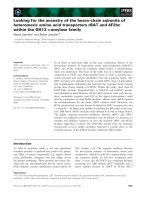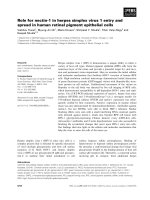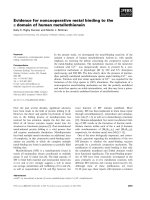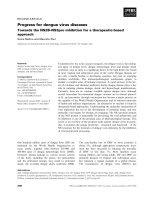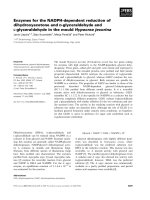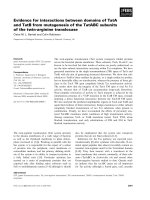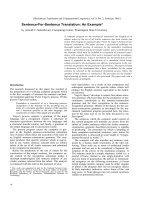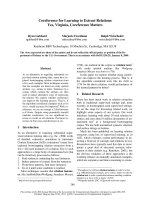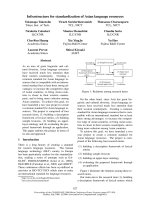Báo cáo khoa học: "Tools for Multilingual Grammar-Based Translation on the Web" docx
Bạn đang xem bản rút gọn của tài liệu. Xem và tải ngay bản đầy đủ của tài liệu tại đây (323.34 KB, 6 trang )
Proceedings of the ACL 2010 System Demonstrations, pages 66–71,
Uppsala, Sweden, 13 July 2010.
c
2010 Association for Computational Linguistics
Tools for Multilingual Grammar-Based Translation on the Web
Aarne Ranta and Krasimir Angelov and Thomas Hallgren
Department of Computer Science and Engineering
Chalmers University of Technology and University of Gothenburg
, ,
Abstract
This is a system demo for a set of tools for
translating texts between multiple languages
in real time with high quality. The translation
works on restricted languages, and is based on
semantic interlinguas. The underlying model
is GF (Grammatical Framework), which is an
open-source toolkit for multilingual grammar
implementations. The demo will cover up to
20 parallel languages.
Two related sets of tools are presented: gram-
marian’s tools helping to build translators for
new domains and languages, and translator’s
tools helping to translate documents. The
grammarian’s tools are designed to make it
easy to port the technique to new applications.
The translator’s tools are essential in the re-
stricted language context, enabling the author
to remain in the fragments recognized by the
system.
The tools that are demonstrated will be ap-
plied and developed further in the European
project MOLTO (Multilingual On-Line Trans-
lation) which has started in March 2010 and
runs for three years.
1 Translation Needs for the Web
The best-known translation tools on the web are
Google translate
1
and Systran
2
. They are targeted to
consumers of web documents: users who want to find
out what a given document is about. For this purpose,
browsing quality is sufficient, since the user has in-
telligence and good will, and understands that she uses
the translation at her own risk.
Since Google and Systran translations can be gram-
matically and semantically flawed, they don’t reach
publication quality, and cannot hence be used by
the producers of web documents. For instance, the
provider of an e-commerce site cannot take the risk that
the product descriptions or selling conditions have er-
rors that change the original intentions.
There are very few automatic translation systems ac-
tually in use for producers of information. As already
1
www.google.com/translate
2
www.systransoft.com
noted by Bar-Hillel (1964), machine translation is one
of those AI-complete tasks that involves a trade-off be-
tween coverage and precision, and the current main-
stream systems opt for coverage. This is also what web
users expect: they want to be able to throw just any-
thing at the translation system and get something useful
back. Precision-oriented approaches, the prime exam-
ple of which is METEO (Chandioux 1977), have not
been popular in recent years.
However, from the producer’s point of view, large
coverage is not essential: unlike the consumer’s tools,
their input is predictable, and can be restricted to very
specific domains, and to content that the producers
themselves are creating in the first place. But even in
such tasks, two severe problems remain:
• The development cost problem: a large amount
of work is needed for building translators for new
domains and new languages.
• The authoring problem: since the method does
not work for all input, the author of the source text
of translation may need special training to write in
a way that can be translated at all.
These two problems have probably been the main
obstacles to making high-quality restricted language
translation more wide-spread in tasks where it would
otherwise be applicable. We address these problems by
providing tools that help developers of translation sys-
tems on the one hand, and authors and translators—i.e.
the users of the systems—on the other.
In the MOLTO project (Multilingual On-Line Trans-
lation)
3
, we have the goal to improve both the devel-
opment and use of restricted language translation by an
order of magnitude, as compared with the state of the
art. As for development costs, this means that a sys-
tem for many languages and with adequate quality can
be built in a matter of days rather than months. As
for authoring, this means that content production does
not require the use of manuals or involve trial and er-
ror, both of which can easily make the work ten times
slower than normal writing.
In the proposed system demo, we will show how
some of the building blocks for MOLTO can already
now be used in web-based translators, although on a
3
www.molto-project.eu
66
Figure 1: A multilingual GF grammar with reversible
mappings from a common abstract syntax to the 15 lan-
guages currently available in the GF Resource Gram-
mar Library.
smaller scale as regards languages and application do-
mains. A running demo system is available at http:
//grammaticalframework.org:41296
.
2 Multilingual Grammars
The translation tools are based on GF, Grammati-
cal Framework
4
(Ranta 2004). GF is a grammar
formalism—that is, a mathematical model of natural
language, equipped with a formal notation for writ-
ing grammars and a computer program implementing
parsing and generation which are declaratively defined
by grammars. Thus GF is comparable with formalism
such as HPSG (Pollard and Sag 1994), LFG (Bresnan
1982) or TAG (Joshi 1985). The novel feature of GF is
the notion of multilingual grammars, which describe
several languages simultaneously by using a common
representation called abstract syntax; see Figure 1.
In a multilingual GF grammar, meaning-preserving
translation is provided as a composition of parsing and
generation via the abstract syntax, which works as an
interlingua. This model of translation is different from
approaches based on other comparable grammar for-
malisms, such as synchronous TAGs (Shieber and Sch-
abes 1990), Pargram (Butt & al. 2002, based on LFG),
LINGO Matrix (Bender and Flickinger 2005, based
on HPSG), and CLE (Core Language Engine, Alshawi
1992). These approaches use transfer rules between
individual languages, separate for each pair of lan-
guages.
Being interlingua-based, GF translation scales up
linearly to new languages without the quadratic blow-
up of transfer-based systems. In transfer-based sys-
4
www.grammaticalframework.org
tems, as many as n(n − 1) components (transfer func-
tions) are needed to cover all language pairs in both di-
rections. In an interlingua-based system, 2n + 1 com-
ponents are enough: the interlingua itself, plus trans-
lations in both directions between each language and
the interlingua. However, in GF, n + 1 components
are sufficient, because the mappings from the abstract
syntax to each language (the concrete syntaxes) are
reversible, i.e. usable for both generation and parsing.
Multilingual GF grammars can be seen as an imple-
mentation of Curry’s distinction between tectogram-
matical and phenogrammatical structure (Curry
1961). In GF, the tectogrammatical structure is called
abstract syntax, following standard computer science
terminology. It is defined by using a logical frame-
work (Harper & al. 1993), whose mathematical basis
is in the type theory of Martin-L
¨
of (1984). Two things
can be noted about this architecture, both showing im-
provements over state-of-the-art grammar-based trans-
lation methods.
First, the translation interlingua (the abstract syntax)
is a powerful logical formalism, able to express se-
mantical structures such as context-dependencies and
anaphora (Ranta 1994). In particular, dependent types
make it more expressive than the type theory used in
Montague grammar (Montague 1974) and employed in
the Rosetta translation project (Rosetta 1998).
Second, GF uses a framework for interlinguas,
rather than one universal interlingua. This makes the
interlingual approach more light-weight and feasible
than in systems assuming one universal interlingua,
such as Rosetta and UNL, Universal Networking Lan-
guage
5
. It also gives more precision to special-purpose
translation: the interlingua of a GF translation system
(i.e. the abstract syntax of a multilingual grammar) can
encode precisely those structures and distinctions that
are relevant for the task at hand. Thus an interlingua
for mathematical proofs (Hallgren and Ranta 2000) is
different from one for commands for operating an MP3
player (Perera and Ranta 2007). The expressive power
of the logical framework is sufficient for both kinds of
tasks.
One important source of inspiration for GF was the
WYSIWYM system (Power and Scott 1998), which
used domain-specific interlinguas and produced excel-
lent quality in multilingual generation. But the gener-
ation components were hard-coded in the program, in-
stead of being defined declaratively as in GF, and they
were not usable in the direction of parsing.
3 Grammars and Ontologies
Parallel to the first development efforts of GF in the
late 1990’s, another framework idea was emerging in
web technology: XML, Extensible Mark-up Language,
which unlike HTML is not a single mark-up language
but a framework for creating custom mark-up lan-
5
www.undl.org
67
guages. The analogy between GF and XML was seen
from the beginning, and GF was designed as a for-
malism for multilingual rendering of semantic content
(Dymetman and al. 2000). XML originated as a format
for structuring documents and structured data serializa-
tion, but a couple of its descendants, RDF(S) and OWL,
developed its potential to formally express the seman-
tics of data and content, serving as the fundaments of
the emerging Semantic Web.
Practically any meaning representation format can
be converted into GF’s abstract syntax, which can then
be mapped to different target languages. In particular
the OWL language can be seen as a syntactic sugar for
a subset of Martin-L
¨
of’s type theory so it is trivial to
embed it in GF’s abstract syntax.
The translation problem defined in terms of an on-
tology is radically different from the problem of trans-
lating plain text from one language to another. Many
of the projects in which GF has been used involve pre-
cisely this: a meaning representation formalized as GF
abstract syntax. Some projects build on previously ex-
isting meaning representation and address mathemati-
cal proofs (Hallgren and Ranta 2000), software speci-
fications (Beckert & al. 2007), and mathematical exer-
cises (the European project WebALT
6
). Other projects
start with semantic modelling work to build meaning
representations from scratch, most notably ones for di-
alogue systems (Perera and Ranta 2007) in the Euro-
pean project TALK
7
. Yet another project, and one clos-
est to web translation, is the multilingual Wiki sys-
tem presented in (Meza Moreno and Bringert 2008).
In this system, users can add and modify reviews of
restaurants in three languages (English, Spanish, and
Swedish). Any change made in any of the languages
gets automatically translated to the other languages.
To take an example, the OWL-to-GF mapping trans-
lates OWL’s classes to GF’s categories and OWL’s
properties to GF’s functions that return propositions.
As a running example in this and the next sec-
tion, we will use the class of integers and the
two-place property of being divisible (“x is divis-
ible by y”). The correspondences are as follows:
Class(pp:integer )
cat integer
ObjectProperty(pp:div
domain(pp:integer)
range(pp:integer))
fun div :
integer -> integer -> prop
4 Grammar Engineer’s Tools
In the GF setting, building a multilingual translation
system is equivalent to building a multilingual GF
6
EDC-22253, webalt.math.helsinki.fi
7
IST-507802, 2004–2006, www.talk-project.org
grammar, which in turn consists of two kinds of com-
ponents:
• a language-independent abstract syntax, giving
the semantic model via which translation is per-
formed;
• for each language, a concrete syntax mapping ab-
stract syntax trees to strings in that language.
While abstract syntax construction is an extra task com-
pared to many other kinds of translation methods, it is
technically relatively simple, and its cost is moreover
amortized as the system is extended to new languages.
Concrete syntax construction can be much more de-
manding in terms of programming skills and linguis-
tic knowledge, due to the complexity of natural lan-
guages. This task is where GF claims perhaps the high-
est advantage over other approaches to special-purpose
grammars. The two main assets are:
• Programming language support: GF is a modern
functional programming language, with a pow-
erful type system and module system supporting
modular and collaborative programming and reuse
of code.
• RGL, the GF Resource Grammar Library, im-
plementing the basic linguistic details of lan-
guages: inflectional morphology and syntactic
combination functions.
The RGL covers fifteen languages at the moment,
shown in Figure 1; see also Khegai 2006, El Dada and
Ranta 2007, Angelov 2008, Ranta 2009a,b, and Enache
et al. 2010. To give an example of what the library
provides, let us first consider the inflectional morphol-
ogy. It is presented as a set of lexicon-building func-
tions such as, in English,
mkV : Str -> V
i.e. function mkV, which takes a string (Str) as its ar-
gument and returns a verb (V) as its value. The verb
is, internally, an inflection table containing all forms
of a verb. The function mkV derives all these forms
from its argument string, which is the infinitive form. It
predicts all regular variations: (mkV "walk") yields
the purely agglutinative forms walk-walks-walked-
walked-walking whereas (mkV "cry") gives cry-
cries-cried-cried-crying, and so on. For irregular En-
glish verbs, RGL gives a three-argument function tak-
ing forms such as sing,sang,sung, but it also has a fairly
complete lexicon of irregular verbs, so that the nor-
mal application programmer who builds a lexicon only
needs the regular mkV function.
Extending a lexicon with domain-specific vocabu-
lary is typically the main part of the work of a con-
crete syntax author. Considerable work has been put
into RGL’s inflection functions to make them as “in-
telligent” as possible and thereby ease the work of the
68
users of the library, who don’t know the linguistic de-
tails of morphology. For instance, even Finnish, whose
verbs have hundreds of forms and are conjugated in
accordance with around 50 conjugations, has a one-
argument function mkV that yields the correct inflection
table for 90% of Finnish verbs.
As an example of a syntactic combination function
of RGL, consider a function for predication with two-
place adjectives. This function takes three arguments: a
two-place adjective, a subject noun phrase, and a com-
plement noun phrase. It returns a sentence as value:
pred : A2 -> NP -> NP -> S
This function is available in all languages of RGL, even
though the details of sentence formation are vastly dif-
ferent in them. Thus, to give the concrete syntax of the
abstract (semantical) predicate div x y (”x is divisi-
ble by y”), the English grammarian can write
div x y = pred
(mkA2 "divisible" "by") x y
The German grammarian can write
div x y = pred
(mkA2 "teilbar" durch_Prep) x y
which, even though superficially using different forms
from English, generates a much more complex struc-
ture: the complement preposition durch Prep takes
care of rendering the argument y in the accusative case,
and the sentence produced has three forms, as needed
in grammatically different positions (x ist teilbar durch
y in main clauses, ist x teilbar durch y after adverbs,
and x durch y teilbar ist in subordinate clauses).
The syntactic combinations of the RGL have their
own abstract syntax, but this abstract syntax is not the
interlingua of translation: it is only used as a library for
implementing the semantic interlingua, which is based
on an ontology and abstracts away from syntactic struc-
ture. Thus the translation equivalents in a multilingual
grammar need not use the same syntactic combinations
in different languages. Assume, for the sake of argu-
ment, that x is divisible by y is expressed in Swedish
by the transitive verb construction y delar x (literally,
”y divides x”). This can be expressed easily by using
the transitive verb predication function of the RGL and
switching the subject and object,
div x y = pred (mkV2 "dela") y x
Thus, even though GF translation is interlingua-based,
there is a component of transfer between English and
Swedish. But this transfer is performed at compile
time. In general, the use of the large-coverage RGL as a
library for restricted grammars is called grammar spe-
cialization. The way GF performs grammar specializa-
tion is based on techniques for optimizing functional
programming languages, in particular partial evalua-
tion (Ranta 2004, 2007). GF also gives a possibility to
run-time transfer via semantic actions on abstract syn-
tax trees, but this option has rarely been needed in pre-
vious applications, which helps to keep translation sys-
tems simple and efficient.
Figure 2: French word prediction in GF parser, sug-
gesting feminine adjectives that agree with the subject
la femme.
As shown in Figure 1, the RGL is currently avail-
able for 15 languages, of which 12 are official lan-
guages of the European Union. A similar number of
new languages are under construction in this collabo-
rative open-source project. Implementing a new lan-
guage is an effort of 3–6 person months.
5 Translator’s Tools
For the translator’s tools, there are three different use
cases:
• restricted source
– production of source in the first place
– modifying source produced earlier
• unrestricted source
Working with restricted source language recognizable
by a GF grammar is straightforward for the translating
tool to cope with, except when there is ambiguity in the
text. The real challenge is to help the author to keep in-
side the restricted language. This help is provided by
predictive parsing, a technique recently developed for
GF (Angelov 2009)
8
. Incremental parsing yields word
predictions, which guide the author in a way similar
to the T9 method
9
in mobile phones. The difference
from T9 is that GF’s word prediction is sensitive to the
grammatical context. Thus it does not suggest all exist-
ing words, but only those words that are grammatically
correct in the context. Figure 2 shows an example of
the parser at work. The author has started a sentence as
la femme qui remplit le formulaire est co (”the woman
who fills the form is co”), and a menu shows a list of
words beginning with co that are given in the French
grammar and possible in the context at hand; all these
words are adjectives in the feminine form. Notice that
the very example shown in Figure 2 is one that is diffi-
cult for n-gram-based statistical translators: the adjec-
tive is so far from the subject with which it agrees that
it cannot easily be related to it.
Predictive parsing is a good way to help users pro-
duce translatable content in the first place. When mod-
ifying the content later, e.g. in a wiki, it may not be
optimal, in particular if the text is long. The text can
8
Parsing in GF is polynomial with an arbitrary exponent
in the worst case, but, as shown in Angelov 2009, linear in
practice with realistic grammars.
9
www.t9.com
69
Pred known A (Rel woman N (Compl
fill V2 form N))
the woman who fills the form is known
la femme qui remplit le formulaire est connue
−→
Pred known A (Rel man N (Compl fill V2
form N))
the man who fills the form is known
l’ homme qui remplit le formulaire est connu
Figure 3: Change in one word (boldface) propagated to
other words depending on it (italics).
contain parts that depend on each other but are located
far apart. For instance, if the word femme (”woman”) in
the previous example is changed to homme, the preced-
ing article la has to be changed to l’, and the adjective
has to be changed to the masculine form: thus con-
nue (”known”) would become connu, and so on. Such
changes are notoriously difficult even for human au-
thors and translators, and can easily leave a document
in an inconsistent state. This is where another utility
of the abstract syntax comes in: in the abstract syntax
tree, all that is changed is the noun, and the regener-
ated concrete syntax string automatically obeys all the
agreement rules. The process is shown in Figure 3. The
one-word change generating the new set of documents
can be performed by editing any of the three represen-
tations: the tree, the English version, or the French ver-
sion. This functionality is implemented in the GF syn-
tax editor (Khegai & al. 2003).
Restricted languages in the sense of GF are close to
controlled languages, such as Attempto (Fuchs & al.
2008); the examples shown in this section are actually
taken from a GF implementation that generalizes At-
tempto Controlled English to five languages (Angelov
and Ranta 2009). However, unlike typical controlled
languages, GF does not require the absence of ambigu-
ity. In fact, when a controlled language is generalized
to new languages, lexical ambiguities in particular are
hard to avoid.
The predictive parser of GF does not try to resolve
ambiguities, but simply returns all alternatives in the
parse chart. If the target language has exactly the same
ambiguity, it remains hidden in the translation. But if
the ambiguity does make a difference in translation, it
has to be resolved, and the system has to provide a pos-
sibility of manual disambiguation by the user to guar-
antee high quality.
The translation tool snapshot in Figure
2 is from
an actual web-based prototype. It shows a slot in an
HTML page, built by using JavaScript via the Google
Web Toolkit (Bringert & al. 2009). The translation
is performed using GF in a server, which is called via
HTTP. Also client-side translators, with similar user in-
terfaces, can be built by converting the whole GF gram-
mar to JavaScript (Meza Moreno and Bringert 2008).
6 The Demo
In the demo, we will show
• how a simple translation system is built and com-
piled by using the GF grammar compiler and the
resource grammar library
• how the translator is integrated in a web page
• how the translator is used in a web browser by
means of an integrated incremental parser
A preliminary demo can be seen in http://
grammaticalframework.org:41296. All the
demonstrated tools are available as open-source soft-
ware from http://grammaticalframework.
org.
The work reported here is supported by MOLTO
(Multilingual On-Line Translation. FP7-ICT-247914).
References
Alshawi, H. (1992). The Core Language Engine. Cam-
bridge, Ma: MIT Press.
Angelov, K. (2008). Type-Theoretical Bulgarian
Grammar. In B. Nordstr
¨
om and A. Ranta (Eds.),
Advances in Natural Language Processing (Go-
TAL 2008), Volume 5221 of LNCS/LNAI, pp. 52–
64. URL />content/978-3-540-85286-5/.
Angelov, K. (2009). Incremental Parsing with Parallel
Multiple Context-Free Grammars. In Proceedings of
EACL’09, Athens.
Angelov, K. and A. Ranta (2009). Implementing Con-
trolled Languages in GF. In Proceedings of CNL-
2009, Marettimo, LNCS. to appear.
Bar-Hillel, Y. (1964). Language and Information.
Reading, MA: Addison-Wesley.
Beckert, B., R. H
¨
ahnle, and P. H. Schmitt (Eds.) (2007).
Verification of Object-Oriented Software: The KeY
Approach. LNCS 4334. Springer-Verlag.
Bender, E. M. and D. Flickinger (2005). Rapid
prototyping of scalable grammars: Towards mod-
ularity in extensions to a language-independent
core. In Proceedings of the 2nd International
Joint Conference on Natural Language Process-
ing IJCNLP-05 (Posters/Demos), Jeju Island, Ko-
rea. URL hington.
edu/ebender/papers/modules05.pdf.
Bresnan, J. (Ed.) (1982). The Mental Representation of
Grammatical Relations. MIT Press.
Bringert, B., K. Angelov, and A. Ranta (2009). Gram-
matical Framework Web Service. In Proceedings of
EACL’09, Athens.
70
Butt, M., H. Dyvik, T. H. King, H. Masuichi,
and C. Rohrer (2002). The Parallel Grammar
Project. In COLING 2002, Workshop on Gram-
mar Engineering and Evaluation, pp. 1–7. URL
/>nltt/pargram/buttetal-coling02.pdf.
Chandioux, J. (1976). M
´
ET
´
EO: un syst
`
eme
op
´
erationnel pour la traduction automatique des bul-
letins m
´
et
´
ereologiques destin
´
es au grand public.
META 21, 127–133.
Curry, H. B. (1961). Some logical aspects of gram-
matical structure. In R. Jakobson (Ed.), Structure of
Language and its Mathematical Aspects: Proceed-
ings of the Twelfth Symposium in Applied Mathemat-
ics, pp. 56–68. American Mathematical Society.
Dada, A. E. and A. Ranta (2007). Implementing an
Open Source Arabic Resource Grammar in GF. In
M. Mughazy (Ed.), Perspectives on Arabic Linguis-
tics XX, pp. 209–232. John Benjamin’s.
Dean, M. and G. Schreiber (2004). OWL Web On-
tology Language Reference. URL http://www.
w3.org/TR/owl-ref/.
Dymetman, M., V. Lux, and A. Ranta (2000).
XML and multilingual document author-
ing: Convergent trends. In COLING,
Saarbr
¨
ucken, Germany, pp. 243–249. URL
/>∼
aarne/
articles/coling2000.ps.gz.
Enache, R., A. Ranta, and K. Angelov (2010). An
Open-Source Computational Grammar for Roma-
nian. In A. Gelbukh (Ed.), Intelligent Text Process-
ing and Computational Linguistics (CICLing-2010),
Iasi, Romania, March 2010, LNCS, to appear.
Fuchs, N. E., K. Kaljurand, and T. Kuhn (2008).
Attempto Controlled English for Knowledge Rep-
resentation. In C. Baroglio, P. A. Bonatti,
J. Małuszy
´
nski, M. Marchiori, A. Polleres, and
S. Schaffert (Eds.), Reasoning Web, Fourth Inter-
national Summer School 2008, Number 5224 in
Lecture Notes in Computer Science, pp. 104–124.
Springer.
Hallgren, T. and A. Ranta (2000). An exten-
sible proof text editor. In M. Parigot and
A. Voronkov (Eds.), LPAR-2000, Volume 1955
of LNCS/LNAI, pp. 70–84. Springer. URL
/>∼
aarne/
articles/lpar2000.ps.gz.
Harper, R., F. Honsell, and G. Plotkin (1993). A
Framework for Defining Logics. JACM 40(1), 143–
184.
Joshi, A. (1985). Tree-adjoining grammars: How
much context-sensitivity is required to provide rea-
sonable structural descriptions. In D. Dowty,
L. Karttunen, and A. Zwicky (Eds.), Natural Lan-
guage Parsing, pp. 206–250. Cambridge University
Press.
Khegai, J. (2006). GF Parallel Resource Grammars and
Russian. In Coling/ACL 2006, pp. 475–482.
Khegai, J., B. Nordstr
¨
om, and A. Ranta (2003).
Multilingual Syntax Editing in GF. In A. Gel-
bukh (Ed.), Intelligent Text Processing and
Computational Linguistics (CICLing-2003),
Mexico City, February 2003, Volume 2588 of
LNCS, pp. 453–464. Springer-Verlag. URL
/>∼
aarne/
articles/mexico.ps.gz.
Martin-L
¨
of, P. (1984). Intuitionistic Type Theory.
Napoli: Bibliopolis.
Meza Moreno, M. S. and B. Bringert (2008). Inter-
active Multilingual Web Applications with Gram-
marical Framework. In B. Nordstr
¨
om and A. Ranta
(Eds.), Advances in Natural Language Processing
(GoTAL 2008), Volume 5221 of LNCS/LNAI, pp.
336–347. URL
ingerlink.
com/content/978-3-540-85286-5/.
Montague, R. (1974). Formal Philosophy. New
Haven: Yale University Press. Collected papers
edited by Richmond Thomason.
Perera, N. and A. Ranta (2007). Dialogue System
Localization with the GF Resource Grammar
Library. In SPEECHGRAM 2007: ACL Workshop
on Grammar-Based Approaches to Spoken Lan-
guage Processing, June 29, 2007, Prague. URL
/>∼
aarne/
articles/perera-ranta.pdf.
Pollard, C. and I. Sag (1994). Head-Driven Phrase
Structure Grammar. University of Chicago Press.
Power, R. and D. Scott (1998). Multilingual authoring
using feedback texts. In COLING-ACL.
Ranta, A. (1994). Type Theoretical Grammar. Oxford
University Press.
Ranta, A. (2004). Grammatical Framework: A
Type-Theoretical Grammar Formalism. The Jour-
nal of Functional Programming 14(2), 145–
189. URL />∼
aarne/articles/gf-jfp.ps.gz.
Ranta, A. (2009a). Grammars as Software Li-
braries. In Y. Bertot, G. Huet, J J. L
´
evy, and
G. Plotkin (Eds.), From Semantics to Computer
Science. Cambridge University Press. URL
/>∼
aarne/
articles/libraries-kahn.pdf.
Ranta, A. (2009b). The GF Resource Gram-
mar Library. In Linguistic Issues in Lan-
guage Technology, Vol. 2. URL http:
//elanguage.net/journals/index.
php/lilt/article/viewFile/214/158.
Rosetta, M. T. (1994). Compositional Translation.
Dordrecht: Kluwer.
Shieber, S. M. and Y. Schabes (1990). Synchronous
tree-adjoining grammars. In COLING, pp. 253–258.
71
